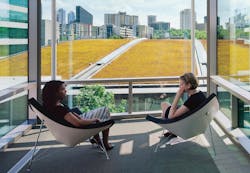Why the auto industry is key to designing healthier, more comfortable buildings
Now that workers have returned to the office at least part of the time, they are reminded of stiff clothing and morning commutes. Another stressor that has been a source of contention for years is temperature—offices that are either too hot or too cold, and the lack of ability to control the climate in these spaces. The baseline temperatures set for buildings is often based on a single person’s experience of the space—a guess at what people are doing, their clothing, and where they are sitting.
However, this one-size-fits-all approach fails to take into account the unique physiological, metabolic, mental and even gendered factors that underpin our experience of—and our preferences around—temperature. And while it might seem like a superfluous consideration, temperature and comfort can significantly impact mental well-being, job satisfaction and performance—not to mention the environment.
The prevailing approach to indoor temperature since the 1960s has been to achieve “thermal comfort,” defined by the American Society of Heating, Refrigerating and Air-Conditioning Engineers (ASHRAE) as the “condition of mind that expresses satisfaction with the thermal environment.” Thermal comfort mandates for the industry have been set with the objective of achieving “a neutral or positive impression of thermal” by 80 percent of building occupants. But even this bar is rarely attained, with people consistently rating high levels of dissatisfaction with the thermal environment of commercial buildings.
But what if there was a way for designers and planners to move beyond the status quo of designing workplaces for thermal comfort to planning environments for thermal delight? Detailed by architect Lisa Heschong, thermal delight plays on the idea of alliesthesia—the pleasure of temperature adjustments like sitting in front of a fireplace in the winter or of jumping into a pool on a hot summer day. It moves beyond a neutral or passable feeling to a feeling of joy in the temperature of our surroundings. And to create the types of environments that prioritize health, comfort and control, the automotive industry provides valuable cues about where to start.
Allowing for Personal Choice
One of the most important predictors of comfort in an environment is the degree of personal control. Gail Brager, a professor at the UC Berkeley College of Environmental Design who has developed new thermal comfort standards adopted by ASHRAE, says, “Our environmental conditioning systems think about heating and cooling spaces rather than heating and cooling people.” Instead, Brager and other researchers like her advocate for a different approach, thinking less about traditional indoor climate and temperature planning for buildings, and looking for inspiration from the personal control we experience within the microclimate of our cars.
Though not ubiquitous across all vehicles, cars provide multiple ways to control the temperature in our individual environment to sustain a pleasant thermal experience over a long period of time. For example, high-end cars feature heated and cooled seats and personal climate control for each passenger. Electric vehicles (EVs) provide a great point of reference since they are uniquely required to find innovative ways of balancing thermal comfort expectations with finite energy reserves. EVs also deploy sophisticated algorithms that estimate the energy required for both passenger comfort and car functionality based on weather and traffic data and charging station proximity and availability.
Balancing Architectural Moves and Interior Choices
Many of the moves that create healthy buildings in general also have a positive impact on temperature, and allow greater personal control in the process—including designing for natural ventilation and buildings that can breathe. Research confirms that occupants of naturally ventilated buildings are comfortable over a much wider range of indoor temperatures compared to occupants of air-conditioned buildings, primarily because of the higher degree of personal control. Indoor temperature is also affected by outdoor air temperature, airflow and humidity, level of sunlight and exposure, surface temperatures, and time of day. Using each of these factors to their greatest advantage means integrating features and elements that are not just passable but enjoyable for different people, such as designing for “adaptive opportunity” with operable windows and adjustable sun shading.
To supplement architectural features that allow for greater personal control, strategic use of furniture and accessories gives people the option to adjust their individual temperature and comfort zones. This includes leveraging recent innovations in industrial design, research and technology, from smart wearable textiles to advanced heated office chairs that both massage and warm to better office fans that provide effective, lower-energy cooling options.
Finally, while still in a nascent stage, exploration of how new technologies—namely related to the Internet of Things (IoT) and Artificial Intelligence (AI)—can move us toward thermal delight approaches in our urban environment is currently underway. For example, building professionals are now studying the potential for wearable technology to leverage biometric and environmental sensing data to build more bespoke models to increase individual thermal satisfaction—and provide a pathway to resolve office temperature conflicts. And researchers out of Purdue University are looking into how machine learning models can be integrated with HVAC systems, testing the approach on a room by room level with demonstrably improved thermal satisfaction.
Environmental Implications of Designing for Thermal Delight
Designing for thermal delight and integrating the architectural and interior elements that allow for greater personal choice is good for people but it’s also better for our environment. HVAC and air conditioning systems make up a significant amount of building energy use and greenhouse gas emissions, adding over 100 million tons of CO2 equivalent per year in the United States alone. This results in a vicious—and ironic—loop of ever more extreme temperatures requiring greater levels of building heating and cooling.
In addition, most commercial buildings use centralized HVAC thermal adjustment and monitoring systems which are great for load flexibility, operations and providing consistently habitable temperatures. But when applied over large thermal zones that subject many people to a singular, often non-adjustable setpoint leaves, they leave something to be desired for most people in those spaces. Solutions like autonomously heated and cooled office chairs provide significant energy savings annually as compared to traditional systems. And by creating more opportunities to adjust personal temperature outside of relying on traditional HVAC—an area that’s seen little innovation since it was first introduced a century ago—we can create more suitable buildings for all stakeholders involved.
Thermal comfort impacts everything from cognition and performance to the environment, and the auto industry provides valuable cues for how to prioritize personal control. By implementing solutions tailored to the individual rather than the general standards around satisfaction of building occupants, we can move beyond thermal comfort to thermal delight.
About the Author
NBBJ
NBBJ creates innovative places and experiences for organizations worldwide, and designs environments, communities, and buildings that enhance people’s lives. Founded in 1943, NBBJ is an industry leader in healthcare and corporate facilities and has a strong presence in the commercial, civic, science, education and sports markets. To view all of NBBJ’s ideas, visit our website or follow us on Facebook, LinkedIn, Twitter

